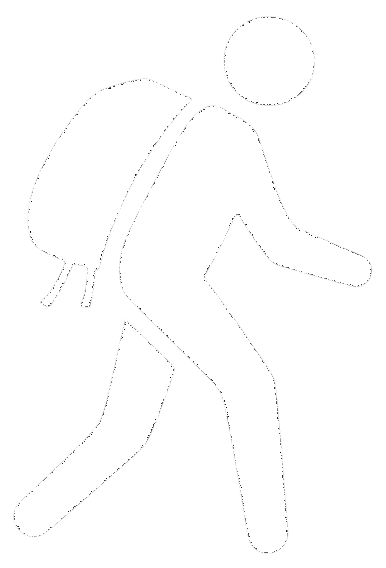Welcome, fellow ruckers. I know many of you are already familiar with regular rucking sessions and do them often. But whether you’re a seasoned pro or a curious beginner, you may not clearly know the answer to the question “what is a ruck march”? Yes, every trip to nature with a weighted backpack can be considered a ruck march, however that is not the original meaning of it.
That’s why I decided to explain everything about this military training and test – what it is, how to prepare, what to eat, and more.
Lace-up your boots, strap on your rucksack, and let’s dive deep into this topic together. The trail awaits, so we have no time to waste!
What is a Rucking March?
Ruck marching has its roots deeply embedded in military training, including air force, national guard, army, marine corps, and other branches.
It is not something new. There is historical evidence that a similar type of training was popular even at the time of the Roman Army, thousands of years ago. Also, if you watched the legendary TV mini-series Band of Brothers, you noticed how the soldiers went through the ruck march as part of their training before being deployed in Europe.
Today, the ruck march is present in almost every army and is part of tryouts as well as annual fitness tests. Names vary, so you’ll find terms like tab, yomp, stomping, forced march, ruck, Norwegian foot march, and hump, depending on the country and military branch.
Also, the weight and the length of the march are different. In the US Army, it is necessary to cover 15 miles within three hours, carrying a load of 70 lb, which is fighting load including rifle. This will earn you the Expert Infantryman Badge (EIB), a prestigious award and status in the special forces.
It is one of the most demanding ruck marches. They vary from a few miles to marathon length, and weight is usually somewhere in the range of 35 to 70 pounds. Terrain plays a crucial role since it makes a huge difference whether they ruck on flat roads or rugged trails.
But don’t let all this military talk intimidate you — rucking is equally popular among regular people who like to try advanced fitness challenges.
So, if you are ready to improve your strength, cardiovascular fitness, and mental resilience, it’s time to explain how to prepare for the ruck march.
Preparation for Ruck March
Since rack marching is an effort for both the brain and body, you must pay attention to both during preparation. Equipment that can withstand the march is also needed.
Physical Conditioning
You can have all the determination in the world, but if you are not physically prepared, you cannot complete the Norwegian ruck march. During preparation, you must target cardiovascular endurance and muscular strength.
Start with aerobic exercise like running, cycling, or swimming. These will elevate heart rate, improve lung capacity, and mimic the sustained effort required during a ruck march. However, without proper planning, you will not achieve the desired results.
Have you heard of the SAID principles? This acronym stands for Specific Adaptation to Imposed Demands. According to SAID, to enhance your ruck performance, tailor your cardiovascular training to match the duration and intensity of your upcoming activities.
In addition to cardiovascular workouts, prioritize strength training exercises. Lower body and core muscle strength are certainly more important than your bench press PR. Yet, that doesn’t mean you should neglect your upper body because that impacts your posture and breathing, among other things.
Squats, lunges, deadlifts, and calf raises are excellent choices for building leg strength and preventing injuries, including chronic problems such as Achilles tendonitis.
Core-strengthening exercises such as planks, Russian twists, and mountain climbers enhance stability and posture during long distance loaded march.
Consistency and progressive overload are key principles in physical conditioning for ruck marching. Gradually increase the duration, intensity, and frequency of your workouts. Remember that rest days are equally important. That is the moment when the body actually adopts the changes and progresses. It is a huge mistake to think that during rest days, you stagnate and, therefore, push too hard. It is a strategy doomed to failure.
Rucking Gear and Equipment
Rucking is a relatively inexpensive activity, but you need to have a few essential pieces of equipment.
In my experience, you should invest in footwear, socks, and a durable and comfortable rucksack.
Look for features such as padded shoulder straps, a supportive waist belt, and adjustable sternum straps to ensure a secure and comfortable fit. Opt for a rucksack with ample storage capacity to accommodate the weight plates you plan to carry.
Hiking boots or trail shoes must have excellent traction and ankle support.
Buying moisture-wicking clothing made from breathable materials is also on top of the priority list because you will sweat, and the weather tends to be unstable.
You may consider additional gear such as trekking poles, a first aid kit, and navigation tools such as a compass or GPS device.
Mental Preparation
It’s not a walk in the park, both figuratively and literally.
Set realistic goals for your march, whether completing a specific distance or maintaining a consistent pace. Setting goals also affects perceived exertion. Otherwise, you may fail and be disappointed. And in fact, you should be proud of yourself because you are preparing for something so challenging.
Many elite athletes, including Novak Djokovic, practice visualization techniques. So, you can try to envision yourself succeeding, which will cultivate a positive mindset.
When faced with setbacks or moments of doubt, don’t hesitate to change the plan temporarily. We must be adaptable to succeed.
Nutrition for Ruck March
As a certified physical trainer and nutritionist, I understand the significance of combining physical training with proper nutrition. Here’s how to prepare, fuel during the ruck, and recover properly later.
Pre-Ruck Meal Planning
Try so-called carb loading in the days before the ruck march, especially in the last 36 hours. Although increased intake of carbs is not useful for activities up to 60 minutes long, it is very beneficial for more prolonged activities, namely a ruck march. (1)
Of course, your meals need to be balanced. You should not eat only carbs without proteins and fats, but increase your carb intake by at least 20%. It will help you endure the effort.
Fueling During the Ruck
Over time, you will learn which snacks are perfect for you. Experienced planners, runners, and marathoners know exactly how to keep their energy levels high with lightweight, high-energy snacks.
Pack energy bars, fruits, and sports drinks. Also, bring things you like that boost strength and energy without causing stomach heaviness.
Post-Ruck Recovery
After completing the ruck march, you will be exhausted.
In the first post-ruck meal, focus on replenishing lost nutrients with a meal rich in carbohydrates and protein.
Later that day and tomorrow, give yourself a break. Eat a pizza, a pancake, a burger, an ice cream, or whatever you want. Your body is depleted and needs high-calorie meals. But that’s not all – your brain also needs rest, and we know how helpful comfort food is.
Many nutritionists advise monitoring every bite, but that is not sustainable long-term. Cheat meals are necessary, especially after tremendous efforts when fast food certainly won’t have any harmful effect on your health or weight. Just be careful not to overeat – you don’t want to spend your recovery day bloated and nauseous.
Bon appétit!
Ruck March Tips and Techniques
I’ve prepared a few tips to help you along the way.
Form and Posture
Form and posture probably won’t affect your ruck march for the first few miles. But after more than an hour, you will start to feel fatigue and discomfort if you don’t keep your shoulders back and your core engaged.
You must distribute the weight of your ruck evenly and reduce strain on your back. Avoid slouching or leaning forward — take short, purposeful steps.
If the terrain is sloping, then I have more tips.
When going uphill, shorten your stride and lean slightly forward. On downhill sections, lean back slightly to control your descent and use your leg muscles to absorb the impact of each step. Trekking poles can be helpful if you feel unstable or have some lingering lower-body injury.
Breathing Techniques
Breathing might seem like a no-brainer, but trust me, many people don’t breathe properly. I notice this both in the gym and in everyday life. People “forget” to breathe or take very shallow breaths, which can be harmful during strenuous physical activity, such as a ruck march.
Take deep breaths in through your nose and out through your mouth. Sync your breathing with your steps.
Pace Management
Finding your rhythm is key to enjoying your march without burning out too soon. Remember, this is not a race, nor a real military rack where you are timed. The point is to enjoy and reach the final destination.
Start at a pace that feels comfortable. Listen to your body along the way, and don’t hesitate to adjust your speed. Sometimes, slowing down a bit can help you go the distance without feeling destroyed for the next seven days.
Frequently Asked Questions
Is rucking suitable for beginners?
The answer is yes. Beginners should not shy away from rucking if they are in good health. Rucking is an excellent activity for beginners looking to improve their fitness level and endurance.
It’s easily adaptable to different fitness levels. Beginners should start with lighter weights and shorter distances and progress gradually. Plus, rucking is a low-impact exercise, making it gentler on the joints compared to running or weightlifting.
What are some common injuries associated with ruck marching, and how can I prevent them?
Blisters, muscle strains, and back pain are common injuries in ruck marching. Sometimes, ankle sprains may occur on challenging terrain. However, these can often be prevented with proper preparation and technique. Ensure your footwear fits well, warm up properly, and hydrate.
Are there any specific stretches or warm-up exercises I should do before a ruck march?
Yes, I advise my clients to do several sets of dynamic stretches to increase blood flow and flexibility in muscles and joints. Additionally, light cardio exercises such as brisk walking or jogging are also good. That will help you elevate your heart rate and prepare your body for the physical demands of rucking.
What are alternative forms of rucking?
Rucking isn’t limited to traditional outdoor trails — you can incorporate it into various environments. During urban ruck, you will walk on city streets, sidewalks, and staircases. It is an accessible option that you can do practically daily. Beach rucking is gaining more and more popularity since it adds an extra challenge due to the sandy terrain. On top of that, it is very enjoyable whether you have river, lake, sea, or ocean views.
What are the benefits of ruck marching compared to other forms of exercise?
Ruck marching offers unique benefits that set it apart from other forms of exercise. Unlike running and weightlifting, which primarily focus on cardiovascular fitness and muscle growth, rucking mainly builds strength and endurance.
Conclusion
Ruck march is indeed more than just a physical challenge — it’s also a mental effort. All that together can have a positive effect on your personal growth, and that’s why I support you in trying ruck marching as soon as you feel physically and mentally ready.
The tips and techniques I told you about in this guide will help you prepare your body and mind, plus prevent injuries and other potential setbacks.
With each mile you cover, you will feel better and better. After you finish your first ruck march, don’t forget to tell me all the details in the comments.
References
- Hawley JA, Schabort EJ, Noakes TD, Dennis SC. Carbohydrate-loading and exercise performance. An update. Sports Med. 1997 Aug;24(2):73-81. doi: 10.2165/00007256-199724020-00001. PMID: 9291549.








